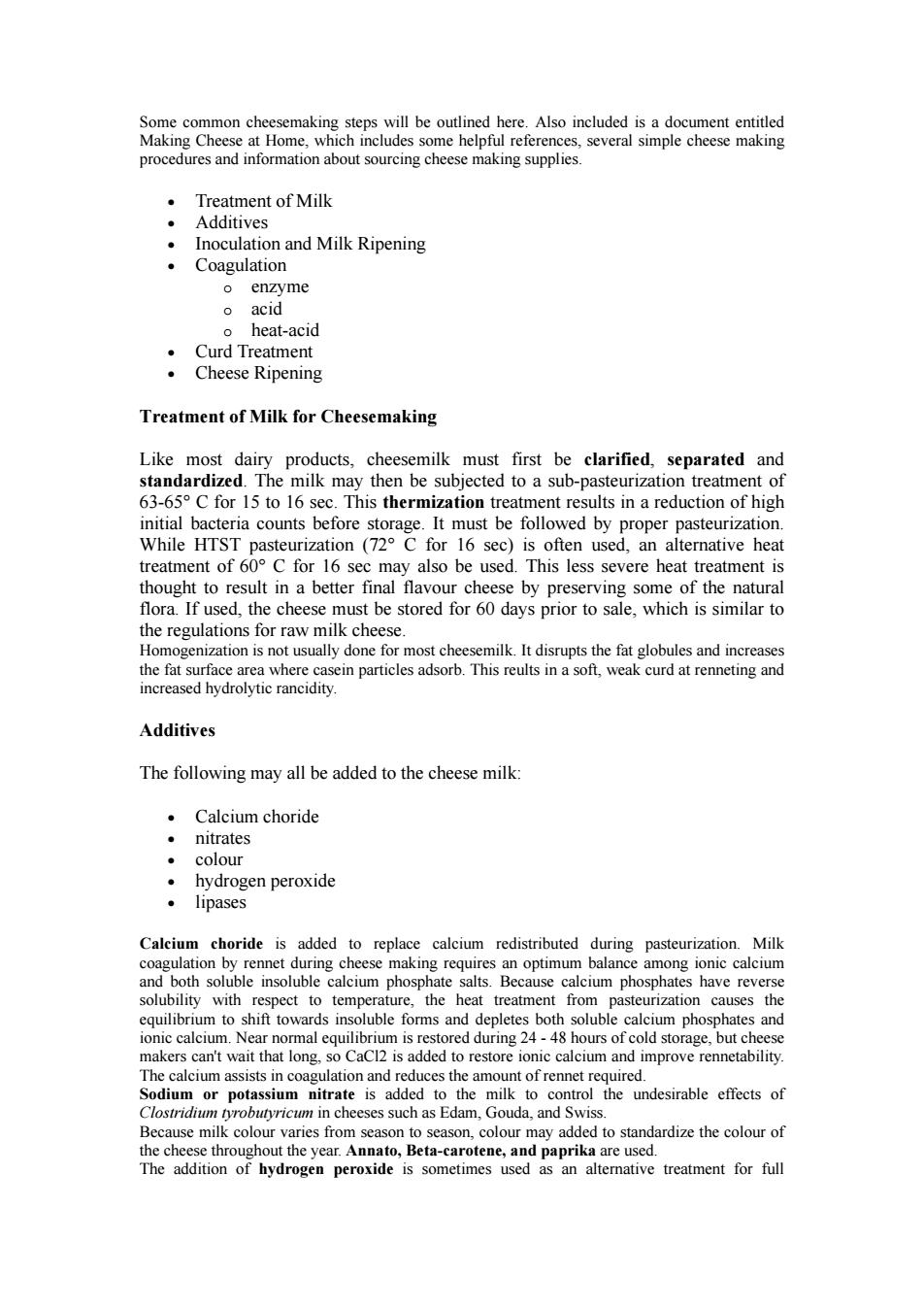正在加载图片...

Mine h makin urcing Treatment of milk 。Additives Inoculation and Milk Ripening 。Coagulat1on o enzyme o acid heat-acic Curd Treatment Cheese Ripening Treatment of Milk for Cheesemaking dized.Tp oducts.chee ust first be clarified,s ythen be subiected to a sub-p separated and nt of 63-65°Cfor15to16se This thermization tre results in a reduction of high initial hacteria counts hefore stora ge it must he followed by proner While HTST pasteurization(72 C for 16 sec)is often used,an alternative heat treatment of 60 C for 16 sec may also be used.This less severe heat treatment is thought to result in a better final flavour cheese by preserving some of the natural flora.If used,the cheese must be stored for 60 days prior to sale,which is similar to the regulations for raw m Ik cheese the t usually done ilk It disrupts the fat globules n pa orb Thi increased hydrolytic rancidity. in a sof t renneting Additives The following may all be added to the cheese milk Calcium choride Calcium choride is added to replace calcium redistributed during pasteurization.Milk among ionic calcium solubility with res nect to temp rature.the heat treatment from asteurization causes the luble forms and deplete soluble ca m phosphate makers can't wait that long so Cac is added to restore ionic calcium and imp The calcium assists in coag um nitrate is ad desirable effects of Because milk colour varies from season to season,colour may added to standardize the colour of e year.An o.Beta-carotene paprik are us treatment for fullSome common cheesemaking steps will be outlined here. Also included is a document entitled Making Cheese at Home, which includes some helpful references, several simple cheese making procedures and information about sourcing cheese making supplies. • Treatment of Milk • Additives • Inoculation and Milk Ripening • Coagulation o enzyme o acid o heat-acid • Curd Treatment • Cheese Ripening Treatment of Milk for Cheesemaking Like most dairy products, cheesemilk must first be clarified, separated and standardized. The milk may then be subjected to a sub-pasteurization treatment of 63-65° C for 15 to 16 sec. This thermization treatment results in a reduction of high initial bacteria counts before storage. It must be followed by proper pasteurization. While HTST pasteurization (72° C for 16 sec) is often used, an alternative heat treatment of 60° C for 16 sec may also be used. This less severe heat treatment is thought to result in a better final flavour cheese by preserving some of the natural flora. If used, the cheese must be stored for 60 days prior to sale, which is similar to the regulations for raw milk cheese. Homogenization is not usually done for most cheesemilk. It disrupts the fat globules and increases the fat surface area where casein particles adsorb. This reults in a soft, weak curd at renneting and increased hydrolytic rancidity. Additives The following may all be added to the cheese milk: • Calcium choride • nitrates • colour • hydrogen peroxide • lipases Calcium choride is added to replace calcium redistributed during pasteurization. Milk coagulation by rennet during cheese making requires an optimum balance among ionic calcium and both soluble insoluble calcium phosphate salts. Because calcium phosphates have reverse solubility with respect to temperature, the heat treatment from pasteurization causes the equilibrium to shift towards insoluble forms and depletes both soluble calcium phosphates and ionic calcium. Near normal equilibrium is restored during 24 - 48 hours of cold storage, but cheese makers can't wait that long, so CaCl2 is added to restore ionic calcium and improve rennetability. The calcium assists in coagulation and reduces the amount of rennet required. Sodium or potassium nitrate is added to the milk to control the undesirable effects of Clostridium tyrobutyricum in cheeses such as Edam, Gouda, and Swiss. Because milk colour varies from season to season, colour may added to standardize the colour of the cheese throughout the year. Annato, Beta-carotene, and paprika are used. The addition of hydrogen peroxide is sometimes used as an alternative treatment for full